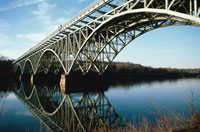Report: Bridges need repair

More than 11 percent of the nation’s highway bridges are listed as “structurally deficient” — meaning they require significant maintenance, rehabilitation or replacement — by the Federal Highway Administration (FHWA), according to a report released Wednesday by Washington-based Transportation for America (T4 America). The report’s release, “The Fix We’re In For: The State of Our Nation’s Bridges,” was timed to coincide with the renewal of debate in Congress over the overdue reauthorization of the federal Safe, Accountable, Flexible, Efficient Transportation Equity Act: A Legacy for Users (SAFETEA-LU).
Of the nation’s approximately 600,000 bridges, the report found that 69,223 are classified as structurally deficient by FHWA, and the agency estimates that $70.9 billion is needed to address the current backlog of deficient bridges. The amount needed will likely increase as many heavily traveled bridges — including those built more than 40 years ago as part of the Interstate System — near the end of their expected lifespan, the report says. “I think we all know that America’s infrastructure is decidedly middle-aged. The average [age of bridges in] the U.S. is now about 42 years old. Most bridges, when they were built, were built for a lifespan of about 50 [years],” T4 America Director James Corless said at a press conference for the report’s release. “That suggests the problem we’ll have in the years ahead if we don’t begin to address this very soon.”
Twenty-three states have higher percentages of deficient bridges than the national average of 11.5 percent, according to “The Fix We’re In For.” Pennsylvania has the highest percentage (26.5 percent) of structurally deficient bridges of any state in the nation, followed by Oklahoma (22 percent), Iowa (21.7 percent), Rhode Island (21.6 percent) and South Dakota (20.3 percent). At the other end of the spectrum, five states have less than 5 percent of their bridges rated as structurally deficient. Nevada leads the rankings at 2.2 percent, followed by Florida (2.4 percent), Texas (3 percent), Arizona (3 percent) and Utah (4.5 percent).
Corless said T4 America wanted to release the report to educate members of Congress about the need for more federal funding for transportation infrastructure as they consider SAFETEA-LU. “Much of the funding for fixing our bridges comes from that bill,” he said. “We are hoping to see more performance measures, more accountability, to really stress repair [and] rehabilitation, and address the backlog of [structurally deficient] bridges.”
Read more and download “The Fix We’re In For,” and use T4 America’s interactive map to locate structurally deficient bridges.




















